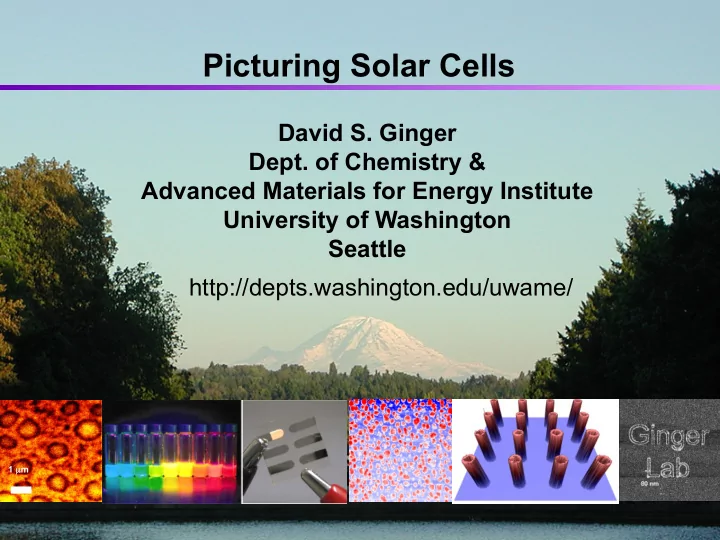

Picturing Solar Cells David S. Ginger Dept. of Chemistry & Advanced Materials for Energy Institute University of Washington Seattle http://depts.washington.edu/uwame/ 0 0 0 0 1 µ m 0 0
Acknowledgements Current Group Members: Dana Sulas Durmus Karatay Phil Cox Matt Gliboff Adam Colbert Hirokazu Nagaoka Guozheng Shao Elisabeth Strein Kristina Knesting Glennis Rayermann Yunqi Yan Dr. Cody Schlenker Dr. Rajiv Giridharagopal Funding: Dr. Michael Salvador ONR Dr. Xin Wang Camille and Henry Dreyfus Foundation DOE EFRC program Recent Undergrads: DOE BES & DOE Solar America Initiative Sam Collins (now at UCSB) NSF NIRT Dave T. Moore (now at Columbia) AFOSR Noah Horwitz (Goldwater Scholar) NSF Angela Hess AFOSR DURIP and BIC program NSF STC MDITR Nick Anderson (to Columbia PhD) NSF UW MRSEC/”GEMSEC” Collaborators Past & Present: Chris Groves (Durham), Alex Jen, Younan Xia, G.Cao Christine Luscombe, Mehmet Sarikaya, Dan Schwartz, Francois Baneyx, Sam Jenekhe, Guozhong Cao, Daniel Gamelin, Lee Park (Williams College)
2010: ~15,000,000,000,000 W (~15 TW) 2035: ~23,000,000,000,000 W (~23 TW) * Ho Chi Minh City *=IAE 2010 “current policies” projection for primary energy demand
Scale Matters: The Big Picture For powering society the scale is terawatts Purple Box = 1 terawatt of solar cells (average) We need materials that are: • Abundant & cheap • Low energy input • Non-toxic • Easy to manufacture
Scale Matters: The Big Picture For powering society the scale is terawatts Purple Box = 1 terawatt of solar cells (average) Orange area = We need materials that are: annual production • Abundant & Cheap of polyethylene in • Low energy input North America • Non-toxic • Easy to manufacture
Can solar cells be as cheap as plastic wrap? polyethylene = insulator = plastic wrap * * n trans -polyacetylene (semiconductor) can make electronic devices * ( Nobel Prize in Chemistry, 2000 ) * n OLED displays are a real technology built on organic molecules
Scale Matters Plastic solar cells require nanostructures that are 10-100 nm across CZTS and CIGS cells are composed of many microscopic grains Hillhouse et al. Prog. in Photovoltaics
The Exciton Bottleneck & Film Morphology nanoscale morphology is critical to polymer photovoltaic performance Acceptor - + - + Donor 1) photoexcitation produces strongly bound excitons 2) pairs must be dissociated at an interface 3) excitons diffuse ~5-20 nm before decaying, but need 100-200 nm thick film to absorb incident light 4) carriers need pathways to electrodes or they can recombine
Scale Matters: The Small Picture Device level view These prototype solar cells contain features 10000X smaller than a human hair Trying to understand them without microscopy is like trying to understand traffic flow in WA state from this altitude
Scale Matters: The Small Picture Device level view = These prototype solar cells contain features 10000X smaller than a human hair Trying to understand them without microscopy is like trying to understand traffic flow in WA state from this altitude
Zooming In • Where does current come from? • Where are the traps? Review by Malliaras and Friend
Zooming In • Where does current come from? • Where are the traps? Review by Malliaras and Friend Early Microscopes
Atomic Force Microscopy Basics Invented by Binning Quate, & Gerber in 1986 Very sharp needle Raster scanning Can measure atom scale forces Image from Opensource Handbook of Nanoscience and Nanotechnology via wikipedia
Atomic Force Microscopy (AFM) for Solar Cells Conductive AFM Photoconductive AFM Electrostatic force microscopy (EFM) Time-resolved EFM
Photoconductive Atomic Force Microscopy Nanoscale tip collects current from solar cell surface
Example: Conductive Atomic Force Microscopy slower drying leads to more fullerene on top faster drying slower drying dark holes 1.4x inc. dark electrons 9x inc. w/ C. Luscombe UW ACS Nano v5 p3132-3140 (2011) – P3HT nanowire/fullerene blends
Example: Photoconductive Atomic Force Microscopy Topography Photocurrent Holes (Dark) Electrons (Dark)
Time-Resolved Electrostatic Force Microscopy Dark Light 2 C ω ∂ 2 ( ) ' o Frequency V V Δ = − − surface tip 2 4 k z ∂
Famous polymer blend Not efficient but important as a model Where does photocurrent come from? (Image by Ana Arias now at UC Berkeley EE)
Time-Resolved Electrostatic Force Microscopy Height Charging Rate 0 0 1 µ m F8BT enriched 0 0 e-acceptor 0 0 0 0 PFB domain 0 0 e-donor 0 um 0 Faster Slower (spin-coated from xylene) 0.8 1.0 1.2 arb. units D. C. Coffey and D. S. Ginger, Nature Materials 5, pp. 735-740, (2006)
Time-Resolved Electrostatic Force Microscopy A picture can predict efficiency! 8 6 7 9 3 4 5 2 10 1 D. C. Coffey and D. S. Ginger, Nature Materials 5, pp. 735-740, (2006)
Limitations on Time Resolution So we could not apply our time-resolved EFM to technique to the most efficient materials …
Improved Time Resolution by 1000X Experiment, model, and numerical simulation all agree! Raj Giridharagopal
Fast trEFM Methods Are Suitable for The Best Materials Nano Letters 12 (2), pp893-898 (2012)
Fast trEFM Methods Are Suitable for The Best Materials increasing annealing time Left column: Nano Letters 9, 2946 (2009), Right : Nano Letters 12 (2), pp893-898 (2012).
Picturing Solar Cells Can Help New microcopes invented at UW (and housed in the MolES building) allow us to take pictures of the inner workings of new solar cell materials 500 nm view = http://depts.washington.edu/gingerlb/
Scale Still Matters Si Li-Ion Battery Anode MoS 2 Catalyst Particle Bi 2 Te 3-y Se y Thermoelectric Polymer Nanowire Solar Cell MRS Bulletin: July 2012 Issue (Editors: Balke, Bonnell, Ginger, Kemerink)
Energy Solutions Must Include: Clean Energy Sources Better Energy Storage Efficient Energy Usage Better Distribution http://depts.washington.edu/uwame/
Recommend
More recommend